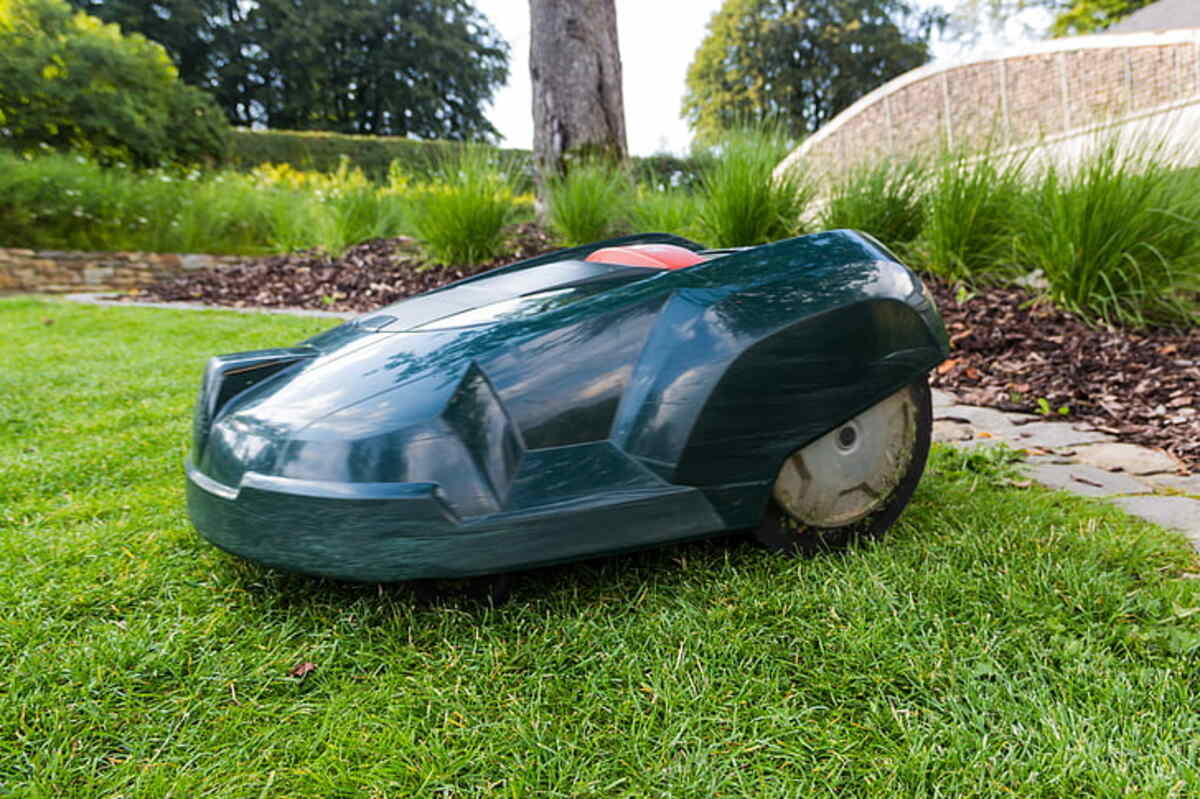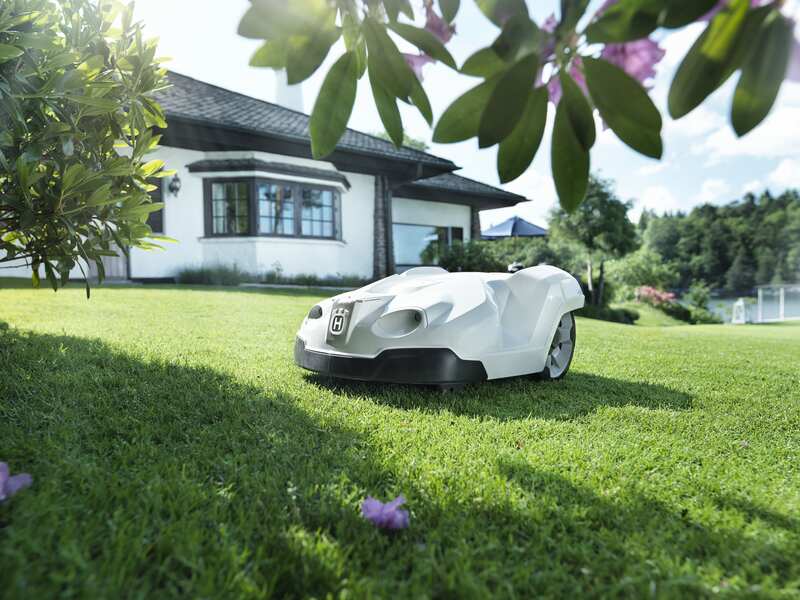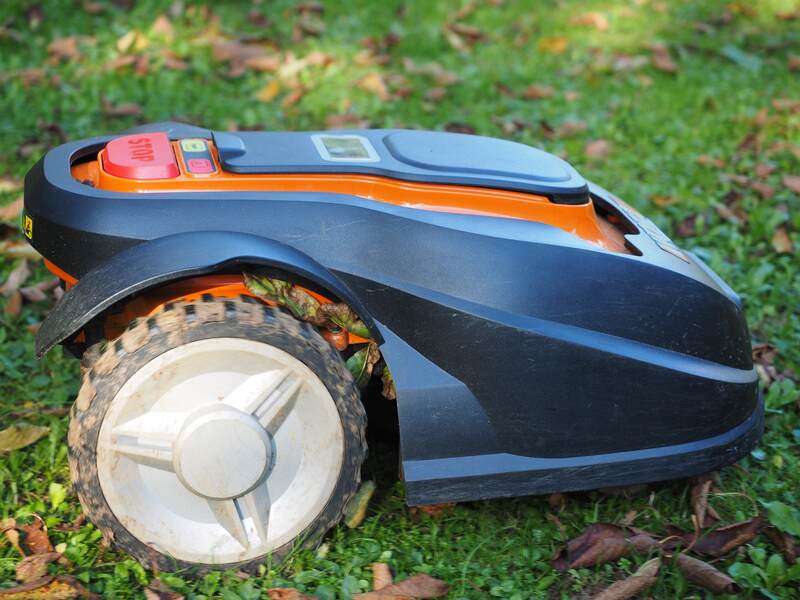
Mowing can be a hassle, especially if you have a large lawn. You might have seen — and envied — those sporty little mowers happily munching away at the neighbor’s grass, cutting each blade to a specific length, and stowing themselves away at the end of the mow. You’d like one but are unsure about them. So how do robot lawn mowers work?
This new technology is catching on, with one market report forecasting a 12.3% annual growth rate in mow-bot sales. Should you jump on the bandwagon and get your own robot mower? Read on.
How Do Robot Mowers Work?
Robot lawn mowers look and act somewhat like your Roomba robot vacuum cleaner. They consist of the following:
Mower
Robot mowers have an electric mower that runs using rechargeable batteries, similar to the Roomba. Smaller than traditional gas-powered mowers, they work continuously, just about every day, and automatically return to their charging stations when they need to restore their power.
If you don’t want to program your cordless wonder from the control panel installed in the unit, you may be able to download apps to control it from a smartphone. Most robot mowers have a PIN code, a theft-protection measure that ensures thieves get no use from them.
Charging Station
This must be placed on a level surface close to an electric socket and protected from sprinklers and direct sunlight. The charging station should be positioned in a central location with a designated space in front and to the sides. For extra, you can purchase a garage for your unit, ensuring it is protected from the elements.
Per Newman Aguiar of Mowbot of the Triangle in South Carolina, “The robot charges and goes out and mows, and then it comes back and charges again, and then goes out and mows again. It is an autonomous machine that manages itself and decides when to mow, how frequently it needs to mow, whether the grass actually needs to be cut.”
Guide Wires and Boundaries
The mowers hustle around your lawn, quietly mowing on a predetermined schedule within a predetermined area of lawn. The area mowed is regulated by guide wires — much like an invisible fence for dogs.
You’ll need to place your guide wires (or have a professional do it) along the lines of your lawn, around trees, flower beds, and other obstacles, in either of two ways:
- Secure them above ground using pegs.
- Bury them in the ground.
Most robot mowers can manage around 220,000 square feet of grass, or just over 5 acres. Some include a rain sensor that stops the mower and returns it to base if bad weather hits.
The technology of lawn robots continues to advance. Manufacturers are developing models that can cut grass without boundary wires and through GPS technology.
Advantages and Disadvantages of Robot Lawn Mowers

Robot lawn mowers may be the lawn mowers of the future, but they may not be the best fit for every lawn. Read these pros and cons before you click “buy now.”
Advantages of Robot Lawn Mowers
Remote-control lawn mowers cut in random patterns, leaving no tracks. They also self-mulch, so you won’t have to deal with grass clippings. Mulching these tiny grass clippings leads to a healthier, happier lawn because they don’t clump, do add nutrients back into the soil, and help keep the lawn from drying out. Other advantages include the following:
- Smartphone accessibility: These compact mowers can often be programmed remotely using your smartphone or even your cloud-based, voice-activated service (Alexa or Google, for example).
- Safety: Built-in safety features (more on that below) keep both your pets and your children safe from the mower and protect the unit from theft.
- Less energy use and pollution: According to the EPA, one gas lawn mower emits 89 pounds of carbon dioxide and 34 pounds of other pollutants per year. The battery-operated robotic unit uses less power for recharging and eliminates pollution from gasoline.
- Less noise pollution: The sound from these quiet robotic units reaches no more than 65 decibels, about the level of a normal conversation. The average push mower operates at around 100 decibels, the same as a car horn.
- Time-saving device: Robo mowers save you time. They don’t care whether it is dark outside or feel guilty for watching that must-see football game. They dutifully follow the installed program and cut the grass.
Disadvantages of Robot Lawn Mowers
Robot lawn mowers should not mow in thunderstorms and wind, but then, neither would you. Other disadvantages include the following:
- Don’t get rid of your string trimmer: You’ll still have to use an edger or trimmer where the automatic lawn mower robot cannot reach, such as along retaining walls and foundations.
- Inclines and hills: The mowers cannot be used on steep inclines, including slopes with grades of 25% to 45%, depending on the brand of mower. Some mower manufacturers claim a 70% slope.
- Time to program the mower: It takes some intensive initial programming to calibrate it to the shape and size of your lawn.
- Time to setup the guide wires: Initially, you’ll need to set up or bury the guide wires.
Safety Features
- PIN codes: Robot lawn mowers have PIN codes that ensure they won’t work if stolen. If someone stops or lifts the mower without a pin code, an alarm sounds. It can’t be used with another docking station.
- Collision sensors: The mower also stops if anyone, including a pet or a child, gets in its way. If interrupted, it stops, turns in a different direction, and continues mowing.
- Lift sensor: Robotic lawn mower blades also cease working if the mower is stopped or lifted, helping prevent injuries. This is particularly important because health care providers in U.S. emergency departments treat nearly 85,000 lawn mower injuries annually.
Mower Cutting Patterns
Robot lawn mowers use an “Edward Scissorhands” style of cutting blades instead of brushing up dog hair and lint like a Roomba. These microblades are lightweight, and the robo mowers cut in a random pattern, preventing unsightly tracks in your lawn. Most brands have safety features that include reverse movement if they bump into anything.
The mowers mow in different directions instead of straight lines, preventing grass “lean” (toward the direction mown). The lighter clipping of blades prevents the lawn from going into shock from a scalping mow.
Not Every Lawn is Ideal for a Robot Lawn Mower

Although smart, today’s models of robotic lawn mowers aren’t smart enough to deal with big ruts, steep hills, or lawns consisting of disconnected islands of grass, so you might have to mow and trim those areas manually. Robot mowers also have problems with small lawn areas with short mowing patterns.
“As designers and homebuilders begin to see the value of this technology,” Aguiar of Mowbot of the Triangle says, “you will start to see it getting adopted more and more over the years, and it will change how consumers look at landscaping.”
Contiguousness: Many traditional lawns, blocked into front and back areas with flower beds, driveways, and other areas, don’t allow a continuous path for a lawn mower robot. “An ideal lawn would be a lawn that is contiguous,” says Aguiar.
“We need to install the perimeter wire that keeps the robot in the yard and also keeps it from going into things like flower beds or around trees or areas that we want to avoid. That wire has to be contiguous because it connects to the charging station where the robot lives and where it recharges,” he explains.
Strips of Uncut Grass: If grass grows against the bottom of a fence or the wall of a home, the robot mower leaves a strip of uncut grass because of the distance between the blade and the edge of the mowing box.
As a result, the homeowner must either hand-mow or edge this grass. You can also install a surface such as brick or gravel around the area so that the robot mower can reach all areas of grass.
Power and Logistics: You must also already have or install an outdoor power outlet in a convenient location for the charging station. You also need to create areas that have a continuous path to and from the charging station and that offer fewer obstacles in a mowing pattern.
Robot Lawn Mower Price
Robot lawn mowers vary in price, beginning around $574 and running up to approximately $17,063. The average cost for a robot mower is $1,470. As with traditional mowers, you’ll need to periodically replace the blades, as well as the lithium-ion battery.
Cost of electricity: This varies from place to place, but one estimate indicates it costs 5 cents to recharge the mower.
If you’re interested in purchasing a robot lawn mower, check out our review of the 5 Best Robot Lawn Mowers.
FAQ
One mowbot manufacturer, Husqvarna, has a calculator for determining which mower to use for your yard size. If you know the measurements for your entire lawn, you can plug them in. Or, if you wish, you can enter your address to load a satellite image of your yard; you then mark the boundaries, and the app lets you know the answer.
Once a year, clean the grass from under the mower itself. At the end of the mowing season, remove the battery and wipe it with a damp cloth to remove any dirt. Store the battery outside of the unit. Don’t expose it to extreme temperatures or moisture. You’ll need to replace it every 2 or 3 years.
Contacts: Check the contacts on the charging station for corrosion. Sand any corrosion with sandpaper; otherwise, the connection between the mower and charger may be lost.
Wiring: Also, look for any damage to wiring and other components; have such damage professionally repaired. Fix any breaks in the guide wire with your manufacturer-provided repair kit.
Robot lawn mowers are becoming increasingly popular in some U.S. cities, but are they for you? Many factors affect which robotic lawn mower is best for you and your yard. These include the following:
● Amount of yard the mower can cut
● Height of the grass blades once the grass is trimmed
● Ability to learn your yard
● GPS technology and smartphone app
● Capacity to set a mowing schedule
● Weather resistance and means to cut wet grass
● Proficiency in trimming edges
● Quality of the blades
● Life of the battery, both after a recharge and in the total life length
LawnStarter has taken out some of the guessing game, citing the 5 best robotic lawn mowers for your yard.
When to Call in the Professionals
Don’t have a robot lawn mower? Hate the hassle of cutting your grass? Let a lawn care professional handle the job of mowing.
Or getting a robot lawn mower and don’t want to mess with installation of the guide wires? You can also have a landscaping professional set them up for you.
Additional sources: U.S. Robotic Lawn Mower Market – Industry Outlook & Forecast 2022-2027
Main Image Credit: Hippopx